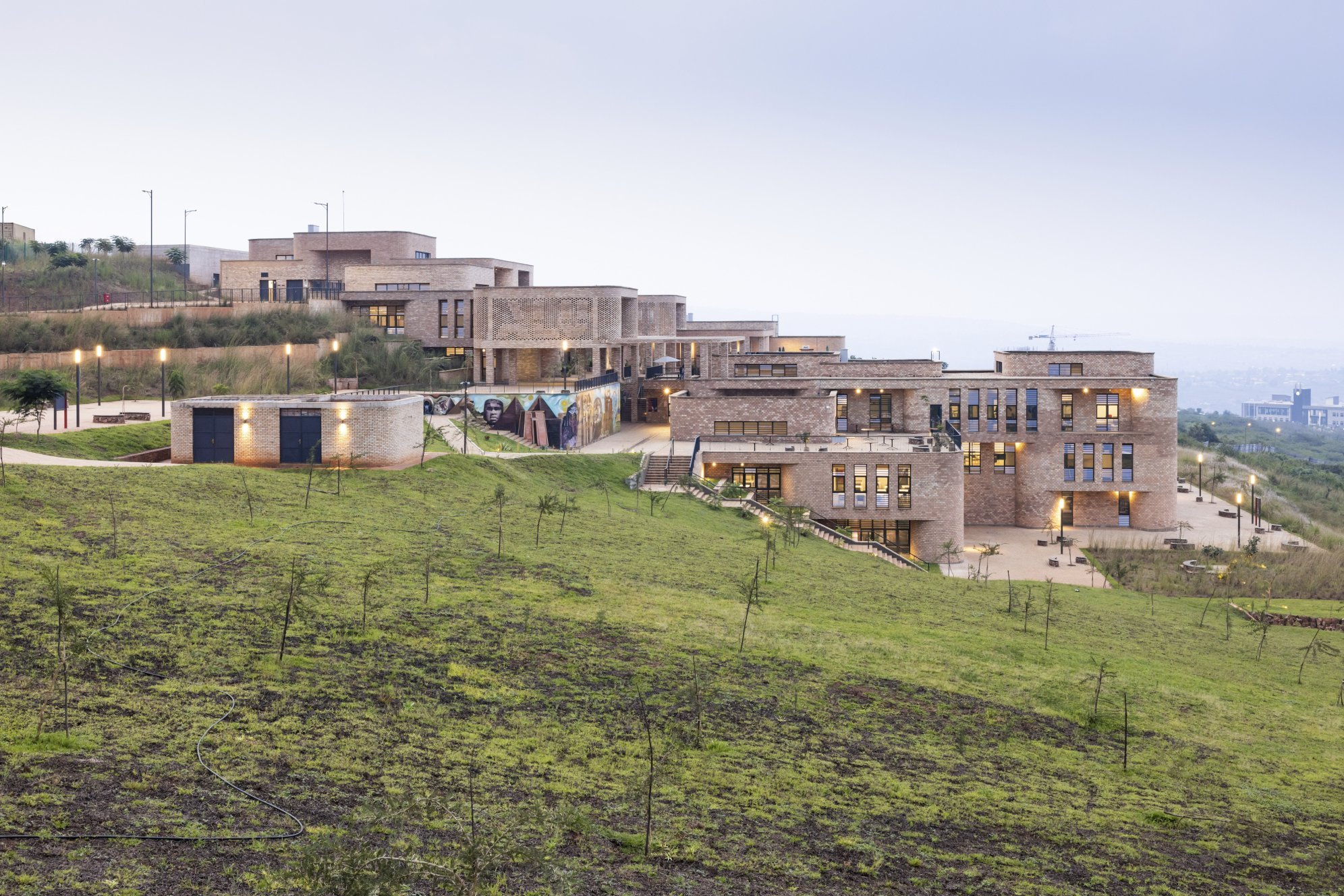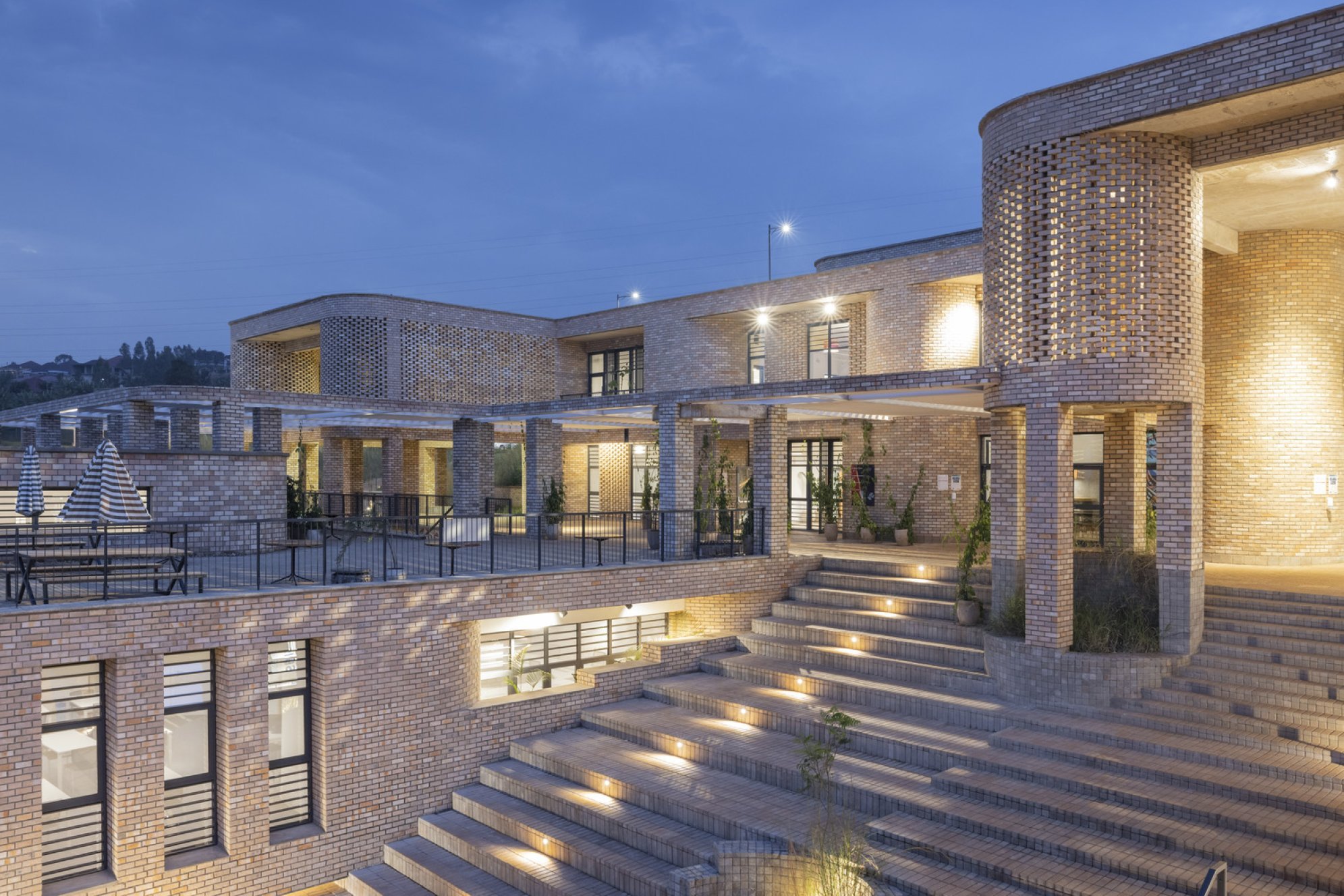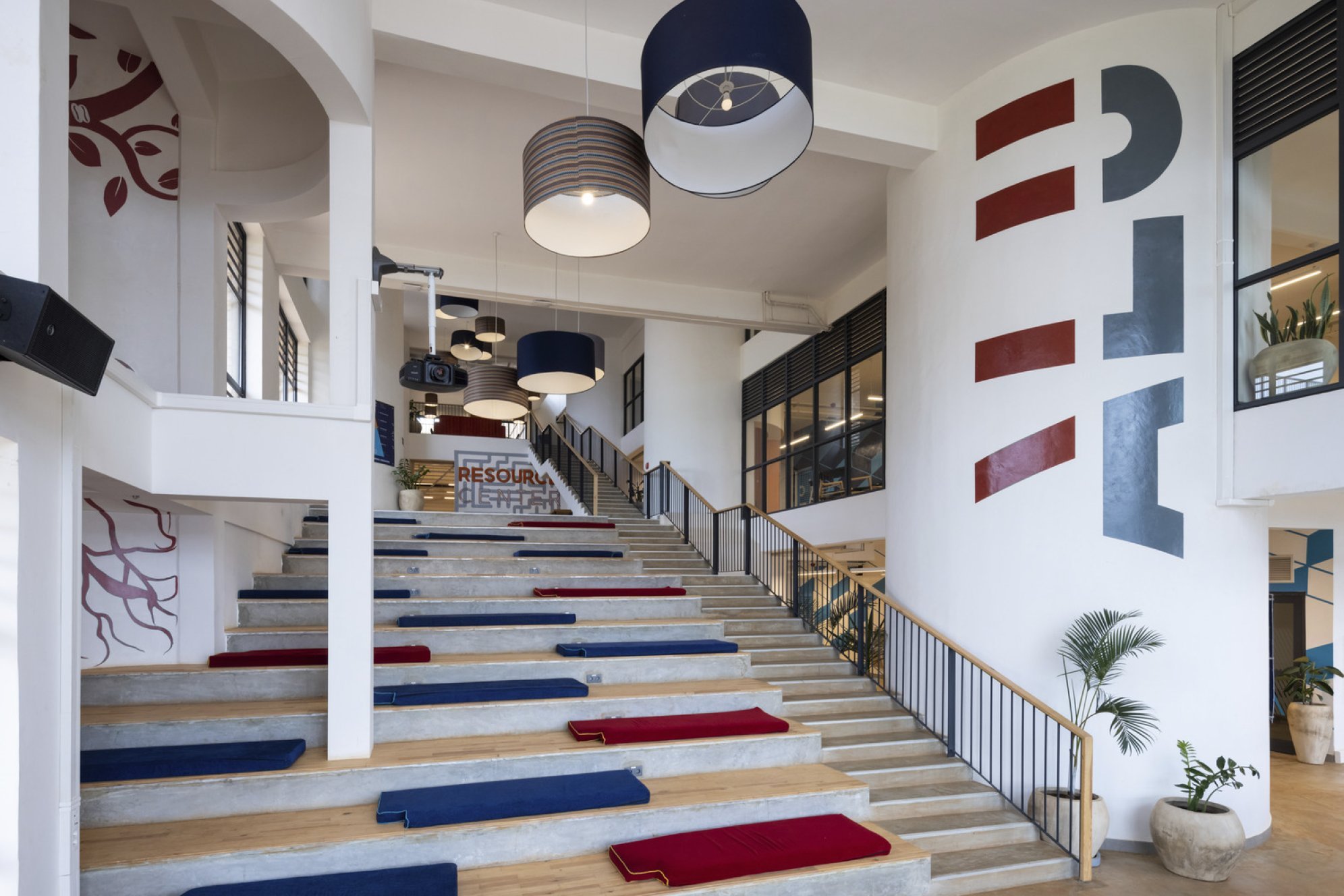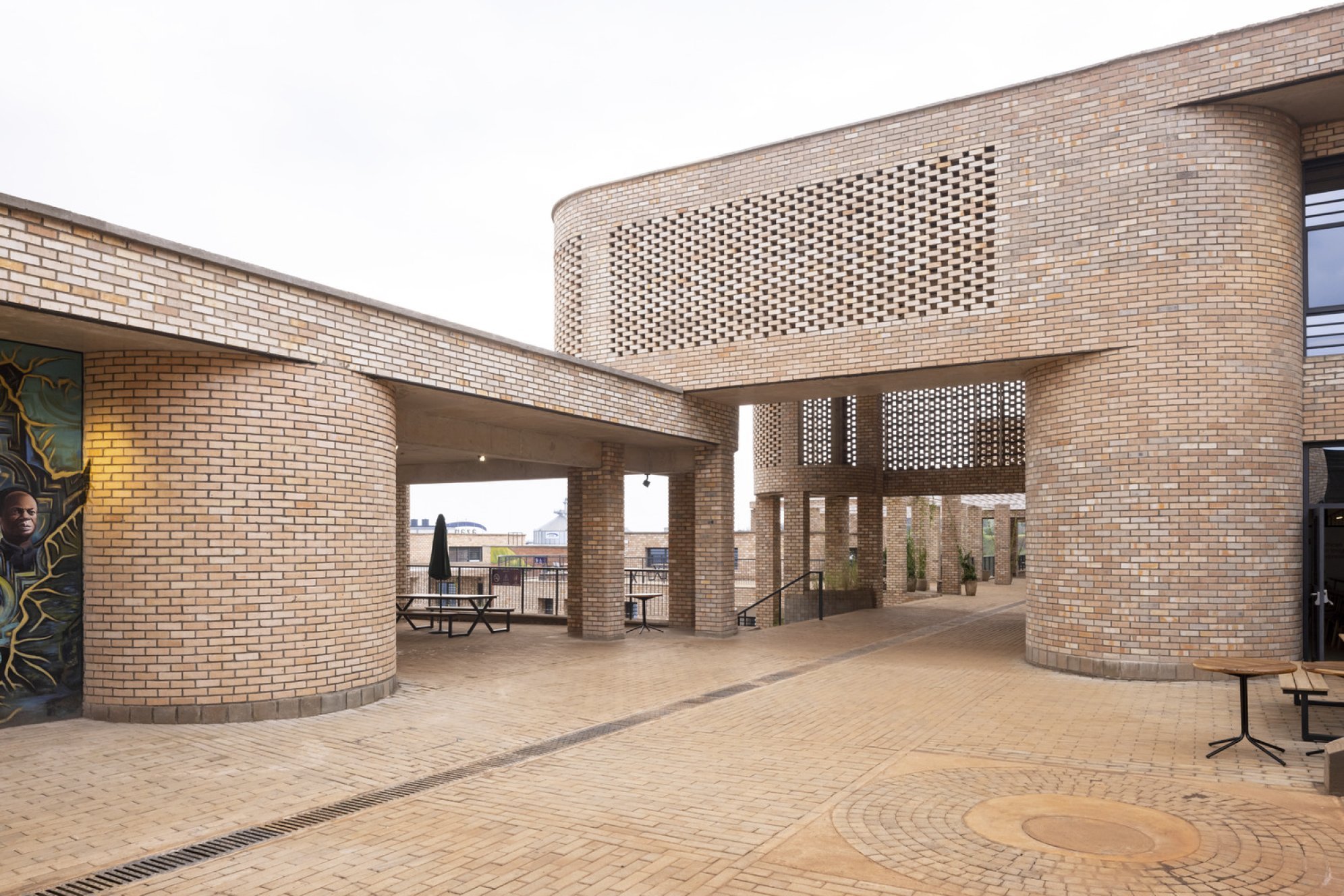African Leadership University Opens Flagship Campus Designed by MASS Design Group

African Leadership University Opens Flagship Campus Designed by MASS Design Group
The Kigali, Rwanda-Based Campus Design Provides an Innovative Model for Educating Africa’s Next Generation of Leaders
BOSTON & KIGALI, Rwanda, June 30, 2021 -- MASS Design Group, a global design firm dedicated to delivering architecture that promotes human dignity, announces the completion of the new flagship campus of the African Leadership University (ALU) in partnership with African Leadership Group’s entrepreneurial founder Fred Swaniker. ALU was constructed in service of Swaniker’s vision to pioneer a new approach to higher education as a holistic experience designed to make students successful entrepreneurs, leaders, and better citizens of the world.
Located in Kigali, Rwanda, the MASS-designed and master-planned 70,000 square-foot (6,500 square-metered) campus features student learning labs, collaborative study spaces, as well as larger shared university commons, and will house 1,200 undergraduate students. With buildings and outdoor spaces, the master plan was designed to meet the educational advancement needs of Africa’s growing populations, which is expected to double by 2050. Through in-depth engagement with leadership, faculty, staff, and students, MASS developed a site-specific program, master plan, and architectural designs to create spaces that work in tandem to support students’ learning and accommodate for future phases of campus growth.
“ALU is changing how education is being designed globally,” said Michael Murphy, Founding Principal and Executive Director of MASS Design Group. “They are building a smaller, right-sized, university campus that utilizes less space for more people. Their vision is replicative and will change the face of leadership, business, and education across the African continent.”

Building Africa’s Leadership Capacity
Founded in Mauritius in 2013, the African Leadership University opened its first campus in Mauritius in 2015, graduated its first class of 173 undergraduate students in 2019 and now graduates more than 300 students a year. Ninety percent of students are employed within six months of graduation with jobs in Africa and around the globe.
From 2012-2017, the number of college-aged students leaving Africa to study abroad increased 26 percent. The aspirational route for top African students seeking higher education is to leave the continent and seek a Western-based education in North America or Europe. After graduation, many do not return leading to brain drain. Those that do return are less suited for the unique challenges they face at home. Understanding this, Swaniker set out to develop a new generation of home-grown African leaders with more relevant knowledge, skills and relationships for Africa.
Replicating the traditional model of Western-based higher education in Africa would have meant developing a model based on scarcity--the continent does not have enough professors with PhDs nor billions of dollars to build excessive physical infrastructure. Swaniker set out instead to develop a model based on abundance: students teach themselves using content that is now readily available online, learn from each other as peers, and learn from real world projects, internships, and student-driven research. The success of the Mauritius-campus gave Swaniker the confidence to expand. He chose Kigali for the second campus due to the Rwandan government’s commitment to developing its economy by investing in human capital and due to the ease of doing business in Rwanda.
“Affordability of, and access to, in-person based educational models and universities will always be an issue, but through the use of technology and access to educational content, networks and experts, today’s student with a smartphone has access to more information than a Ph.D. candidate did 30 years ago,” said Swaniker. “Constraints drive innovation for both our new model of education at ALU, and what our students can accomplish.”
With Africa’s projected growth, 50 percent of the population will be under the age of 25 by 2050, making it a fast-growing continent that faces many grand challenges, including healthcare, infrastructure, climate change, education, food security, environmental sustainability, human relations, and clean manufacturing. Swaniker’s vision is for ALU graduates to become problem-solvers who will address these challenges in innovative ways.
As such, ALU students are asked not to declare a traditional academic major. Instead, they declare a ‘mission’ related to addressing one of these grand challenges facing Africa. They research these issues to create a thesis as well as a business plan.

ALU’s Learning Model and Design Integration: Designed for Africa’s Future Leaders
ALU selected MASS to design the main campus in support of its unique education model. The campus was conceived so that Kigali-based students could convene for in-person study, group work and events. ALU’s education model required the space to be available and flexible to allow students to spend time on campus, but also return to cities where they live and use mobile devices or networks to stay in touch with their global network of teachers.
Space is organized into three connected spaces: the Learning, Social, and Enterprise Commons. The campus design includes student learning labs; a reception and greeting space for group gatherings; resource commons; a faculty area; a leadership center for events and presentations; a dining hall and food vendors; and a fabrication lab where students can prototype and test ideas.
MASS addressed learning and information sharing at ALU, which is either through online and individual learning or small-group discussions, facilitated by peers or faculty. Space normally allocated for large classrooms or lecture halls could be turned into individual and small group learning spaces. A modular and structural grid was created based on these parameters to create open spaces that allowed for greater flexibility of use. The model enabled MASS to think about the building in smaller increments, stacking and nesting cohorts of learning labs and work hives, and linking them together around shared commons.
“We want to break down the barrier between those who are serving, the students - faculty and staff - and the students themselves,” said Swaniker. “These spaces help make the academic community very accessible, to encourage a wide exchange of ideas. Physical design is just one way in which we are reimagining learning."
Circular study pods were assigned to the grid and distributed across the campus within or adjacent to larger work hives and common areas. Students and faculty can peel off to focus in smaller pods individually, or meet in larger pods for group work or experience sharing. The gridded modules between the pods support 30 students for facilitated learning and for larger classes, gatherings, or lectures, the modules are connected into larger spaces and shared commons. The modular design reflects ALU’s unique learning cycle with spaces dedicated to self, peer, and facilitated learning and an interconnected campus to support discovery.
“We leveraged ALU’s fundamental learning model to help inform how we would design the campus and spaces as a place of inspiration, access, and networking, with space for individual study and exploration,” said Nicki Reckziegel, a Design Director at MASS Design Group’s Kigali, Rwanda-based office.
The pod structure is also utilized for building services, including mechanical and electrical risers, elevators, circulation, and storage. The circular form of the pods carry throughout the design, expressed and occupied on the exterior, forming the filleted corners of the building and terraces. Exterior pods emerge in the landscape, creating exterior learning spaces and provide the pattern and dimension for pavers and location for trees and plantings.

ALU’s Campus in The Land of A Thousand Hills
ALU’s campus is situated in Kigali’s Innovation City, a Rwandan-government designated district for the co-location of tech companies, start-ups, and universities. Rwanda, known as The Land of a Thousand Hills, is a land of mountain views surrounded by volcanoes, which makes for amazing vistas and a challenge for building design. To accommodate the use of the ALU 10-hectares site with a 40-meter (131 feet) elevation span, the building is terraced over six levels.
The design pursues spatial efficiency by weaving interior and exterior spaces, such as courtyards and terraces, which take advantage of Kigali’s year-round temperate climate. The building is situated and designed to take advantage of shaded areas to the east and west, with views down the hill to the south. The majority of the building uses natural ventilation and daylight. A Heating, Ventilation, and Air Conditioning (HVAC) system supports interior parts of the building, further away from the facade and natural ventilation.
“The landscape of Rwanda inspires, from the volcanic mountain peaks to the green valleys, and ALU’s positioning maximizes the views and vistas that will inspire the next generations of Africa's leadership,” said Christian Benimana, Managing Director, and Senior Principal of MASS Design Group’s Kigali, Rwanda-based office. “Situated in Innovation City with a navigable campus that is both distributed and interconnected down the hill, the design invites in, and will allow for integration, with the surrounding businesses and government agencies nearby.”
Due to the project’s elevation-related complexity, there isn’t a single floor plan that can fully represent the project. The project uses modules stacked and linked together to create new spaces of learning and interaction. The floor of one plaza is the roof of a classroom below. MASS also worked closely with in-house geotechnical engineers and engineering partner ARUP to ensure seismic performance.

ALU’s Facade and Interior: Locally Sourced and Made
MASS employs locally fabricated (Lo-Fab) design to scale local innovation and ideas; bolster and develop local crafts; hire local labor; invest in capacity building and job training; and reduce the building’s carbon-footprint through reduced materials transportation distance and use of local materials. Working with locally sourced materials and labor, MASS reduces the supply chain for environmental impact, and assures that the majority of capital invested in construction flows to the community.
The ALU building is a concrete frame infilled with compressed stabilized earth blocks (CSEB) fabricated on site, with a light-colored clay brick facade. Made in Muhanga 1.5 hours outside of Kigali, the bricks are design-inspired, energy-efficient, low-maintenance, relatively weather-proof, and sustainable. Skat Consulting, Inc., supports and trains local brick manufacturers to fire the bricks using coffee-husk-fired efficient kilns.
The stormwater management system includes a stormwater retention pond of approximately 1800cum capacity.
In addition, MASS deployed Lo-Fab methodology by designing and building part of the furnishings, including tables and benches for common spaces, as well as built-ins, lighting, signage, and lockers. Painted by local artists, Afrofuturist murals, branded wall graphics, and provocative quotes from African leaders, are distributed throughout the campus providing moments of inspiration and reflection.
ALU represents MASS's largest higher education facility opened to date. MASS’s other education work, also leveraging Lo-Fab methodology, includes the design of the University of Global Health Equity (Butaro, Rwanda), the Umubano Primary School (Kigali, Rwanda); Ilima Conservation School (Ilima, Democratic Republic of Congo); Mubuga Primary School and Ruhehe Primary School (Ruhengeri, Rwanda) and to open in fall 2021, the Rwanda Institute for Conservation Agriculture.

About African Leadership University:
African Leadership University or ALU is a network of tertiary institutions with operations in both Mauritius and Rwanda. ALU is part of the African Leadership Group, which aims to develop 3 million ethical and entrepreneurial leaders for Africa and the world by 2035. ALU was developed as an innovative learning model that provides affordable access to higher education across the continent, based on four phases of self-directed learning around issues of interest: Discovery; Individual Learning; Peer Groups; and Facilitated Learning. The university’s design advances ALU’s learning methodology, focused on individual and small group learning spaces, with an emphasis on collaborative online and remote learning brought together through peer groups and facilitated expert conversation. ALU has more than 50 faculty employed by the Kigali and Mauritius campuses who teach in person and online. Their teaching is complemented by guest faculty and student access to massive open online courses taught by field experts ranging from Harvard University and Oxford University to specialization courses appropriate to a student’s independent learning and course of study.
About MASS Design Group:
A Model of Architecture for Society (MASS) Design Group was founded in 2008 as a non-profit organization motivated by an idea for a different way of practice. MASS grew to include many colleagues and contributors who worked together to design and build the Butaro District Hospital in Rwanda, a project of Partners In Health and the Rwandan Ministry of Health. Since then, the organization has grown to a team of 140 architects, landscape architects, engineers, builders, furniture designers, writers, filmmakers, and researchers representing 20 countries across the globe. MASS operates design labs including the Restorative Justice Design Lab in Boston; Sustainable Native Communities Design Lab in Sante Fe, N.M.; and the Food Systems and Fringe Cities Lab in Hudson Valley, N.Y.
Principal In Charge: Patricia Gruits
Project Manager: Nicki Reckziegel
Design Team:
Michael Murphy, Patricia Gruits, Nicki Reckziegel, Emily Goldenberg, Bethel Abate, Lysette Niragira, Aziz Farid Shyaka, Symphorien Gasana,
Construction Administration Team:
Jean Damascene Sekamana, Obed Sekamana, Cam Bailey, Tilly Lenartowicz, Christian Uwinkindi, Gilbert Herve Ngenzi, Harriet Kirk, Greg Dalke, Adam Saltzman, Christian Benimana
Supporting Team:
Martine Dushime, Josh Greene, Therese Graf, Alex Dallas, Shakira Nyiratuza, Jenny Kay, Nelson Habintwari, Lamy Subira, Sherryen Mutoka, Giorgio Azzariti, Ines Uwimbabazi, Kelly Doran, Sarah Mohland
Project Consultant(s)
Arup (Structural and Civil Engineering)
The Landscape Studio (Landscape Architecture)
MEW Consultants LTD (Quantity Surveying)
SUMMA (Contractor)
